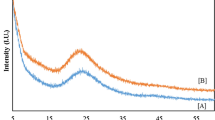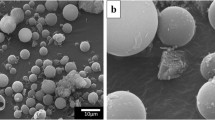Abstract
Tyrosinase from Agaricus bisporus was immobilised covalently on mesostructured siliceous foam (MCF) and three mesoporous silicas of SBA-15 type of different pore sizes, regarded as the reference, to reveal that MCF was the superior enzyme support. All the carriers were functionalised using 3-aminopropyltrimethoxysilane and the enzyme was attached covalently via glutaraldehyde or by simple adsorption and it was also cross-linked with glutaraldehyde in selected samples. The experiments indicated that only tyrosinase attached covalently was highly active and that postimmobilisation cross-linking slightly reduced its activity with no improvement in stability. MCF-bound tyrosinase was the best biocatalyst with monophenolase and diphenolase activities of 3627 U mL−1 and 53040 U mL−1 of carrier sediment, respectively. Inactivation studies at 55°C showed that MCF-bound tyrosinase was 20 times more stable than the native enzyme, whereas for typical SBA-15 it was only 12 times. A comparative study with other, non-siliceous enzyme supports indicated that aminated MCF appeared to be the carrier of choice for the covalent attachment of tyrosinase.
Similar content being viewed by others
References
Ates, S., Cortenlioglu, E., Bayraktar, E., & Mehmetoglu, U. (2007). Production of l-DOPA using Cu-alginate gel immobilized tyrosinase in batch and packed bed reactor. Enzyme and Microbial Technology, 40, 683–687. DOI: 10.1016/j.enzmictec.2006.05.031.
Bryjak, J., Szymańska, K., & Jarzębski, A. B. (2012). Laccase immobilisation on mesostructured silicas. Chemical and Process Engineering, 33, 611–620. DOI: 10.2478/v10176-012-0051-9.
Burton, S. G. (2003). Laccases and phenol oxidases in organic synthesis — a review. Current Organic Chemistry, 7, 1317–1331. DOI: 10.2174/1385272033486477.
Chaudhary, Y. S., Manna, S. K., Mazumdar, S., & Khushalani, D. (2008). Protein encapsulation into mesoporous silica hosts. Microporous and Mesoporous Materials, 109, 535–541. DOI: 10.1016/j.micromeso.2007.06.001.
de Faria, R. O., Rotunno Moure, V., de Almeida Amazonas, M. A. L., Krieger, N., & Mitchell, D. A. (2007). The biotechnological potential of mushroom tyrosinases. Food Technology & Biotechnology, 45, 287–294.
Durán, N., Rosa, M. A., D’Annibale, A., & Gianfreda, L. (2002). Applications of laccase and tyrosinases (phenoloxidases) immobilized on different supports: a review. Enzyme and Microbial Technology, 31, 907–931. DOI: 10.1016/s0141-0229(02)00214-4.
Espín, J. C., Soler-Rivas, C., Cantos, E., Tomás-Barberán, F. A., & Wichers, H. J. (2001). Synthesis of the antioxidant hydroxytyrosol using tyrosinase as biocatalyst. Journal of Agricultural and Food Chemistry, 49, 1187–1193. DOI: 10.1021/jf001258b.
Franssen, M. C. R., Steunenberg, P., Scott, E. L., Zuilhof, H., & Sanders, J. P. M. (2013). Immobilised enzymes in biorenewables production. Chemical Society Reviews, 42, 6491–6533. DOI: 10.1039/c3cs00004d.
Frąckowiak-Wojtasek, B., Gąsowska-Bajger, B., Mazurek, M., Raniszewska, A., Logghe, M., Smolarczyk, R., Cichoń, T., Szala, S., & Wojtasek, H. (2014). Synthesis and analysis of activity of potential anti-melanoma prodrug with a hydrazine linker. European Journal of Medicinal Chemistry, 71, 98–104. DOI: 10.1016/j.ejmech.2013.10.080.
García-Molina, F., Muñoz, J. L., García-Ruíz, P. A., Rodríguez López, J. N., García-Cánovas, F., Tudela, J., & Varón, R. (2007). A further step in the kinetic characterization of the tyrosinase enzymatic system. Journal of Mathematical Chemistry, 41, 393–406. DOI: 10.1007/s10910-006-9082-0.
Gąsowska, B., Kafarski, P., & Wojtasek, H. (2004). Interaction of mushroom tyrosinase with aromatic amines, o-diamines and o-aminophenols. Biochimica et Biophysica Acta, 1673, 170–177. DOI: 10.1016/j.bbagen.2004.04.013.
Gouzi, H., & Benmansour, A. (2007). Partial purification and characterization of polyphenol oxidase extracted from Agaricus bisporus (J.E. Lange) Imbach. International Journal of Chemical Reactor Engineering, 5(1). DOI: 10.2202/1542-6580.1445.
Hudson, S., Cooney, J., & Magner, E. (2008). Proteins in mesoporous silicates. Angewandte Chemie International Edition, 47, 8582–8594. DOI: 10.1002/anie.200705238.
Holaouli, S., Asther, M., Sigoillot, J. C., Hamdi, M., & Lomascolo, A. (2006). Fungal tyrosinases: New prospects in molecular characteristics, bioengineering and biotechnological applications. Journal of Applied Microbiology, 100, 219–232. DOI: 10.1111/j.1365-2672.2006.02866.x.
Ikehata, K., & Nicelli, J. A. (2000). Characterization of tyrosinase for the treatment of aqueous phenols. Bioresource Technology, 74, 191–199. DOI: 10.1016/s0960-8524(00)00025-0.
Jarzębski, A. B., Szymańska, K., Bryjak, J., & Mrowiec-Białoń, J. (2007). Covalent immobilization of trypsin on to siliceous mesostructured cellular foams to obtain effective biocatalysts. Catalysis Today, 124, 2–10. DOI: 10.1016/j.cattod.2007.03.023.
Kampmann, M., Boll, S., Kossuch, J., Bielecki, J., Uhl, S., Kleiner, B., & Wichmann, R. (2014). Efficient immobilization of mushroom tyrosinase utilizing whole cells from Agaricus bisporus and its application for degradation of bisphenol A. Water Resource, 57, 295–303. DOI: 10.1016/j.watres.2014.03.054.
Karim, M. N., Lee, J. E., & Lee, H. J. (2014). Amperometric detection of catechol using tyrosinase modified electrodes enhanced by the layer-by-layer assembly of gold nanocubes and polyelectrolytes. Biosensors & Bioelectronics, 61, 147–151. DOI: 10.1016/j.bios.2014.05.011.
Labus, K., Turek, A., Liesiene, J., & Bryjak, J. (2011). Efficient Agaricus bisporus tyrosinase immobilization on cellulose-based carriers. Biochemical Engineering Journal, 56, 232–240. DOI: 10.1016/j.bej.2011.07.003.
Lei, C. H., Shin, Y. S., Magnusom, J. K., Fryxell, G., Lasuje, L. L., Elliott, D. C., Liu, J., & Akerman, J. (2006). Characterization of functionalized nanoporous supports for protein confinement. Nanotechnology, 17, 5531–5538. DOI: 10.1088/0957-4484/17/22/001.
Lowry, O. H., Rosebrough, N. J., Farr, A. L., & Randall, R. J. (1951). Protein measurement with the Folin phenol reagent. Journal of Biological Chemistry, 193, 265–275.
Min, K. S., Ryu, J. H., & Yoo, Y. J. (2010). Mediator-free glucose/O2 biofuel cell based on a 3-dimenional glucose oxidase/SWNT/polypyrrole composite electrode. Biotechnology & Bioprocess Engineering, 15, 371–375. DOI: 10.1007/s12257-009-3034-z.
Morales, M. D., Morante, S., Escarpa, A., González, M. C., Reviejo, A. J., & Pingarrón, J. M. (2002). Design of a composite amperometric enzyme electrode for the control of benzoic acid content in food. Talanta, 57, 1189–1198. DOI: 10.1016/s0039-9140(02)00236-9.
Mrowiec-Białoń, J. (2006). Determination of hydroxyls density in the silica mesostructured cellular foams by thermogravimetry. Thermochimica Acta, 443, 49–53. DOI: 10.1016/j.tca.2005.12.014.
Pierre, A. C. (2004). The sol-gel encapsulation of enzymes. Biocatalysis & Biotransformation, 22, 145–170. DOI: 10.1080/10242420412331283314.
Ren, L. W., Jia, H. H., Yu, M., Shen, W. Z., Zhou, H., & Wei, P. (2013). Enhanced catalytic ability of Candida rugosa lipase immobilized on pore-enlarged hollow silica microspheres and cross-linked by modified dextran in both aqueous and non-aqueous phases. Biotechnology & Bioprocess Engineering, 18, 888–896. DOI: 10.1007/s12257-013-0044-7.
Rekuć, A., Bryjak, J., Szymańska, K., & Jarzębski, A. B. (2009). Laccase immobilization on mesostructured cellular foams affords preparations with ultra high activity. Process Biochemistry, 44, 191–198. DOI: 10.1016/j.procbio.2008.10.007.
Seo, S. Y., Sharma, V. K., & Sharma, N. (2003). Mushroom tyrosinase: Recent prospects. Journal of Agricultural & Food Chemistry, 51, 2837–2853. DOI: 10.1021/jf020826f.
Sigolaeva, L. V., Gladyr, S. Y., Gelissen, A. P., Mergel, O., Pergushov, D. V., Kurochkin, I. N., Plamper, F. A., & Richtering, W. (2014). Dual-stimuli-sensitive microgels as a tool for stimulated spongelike adsorption of biomaterials for biosensor applications. Biomacromolecules, 15, 3735–3745. DOI: 10.1021/bm5010349.
Szymańska, K., Bryjak, J., & Jarzębski, A. B. (2009). Immobilization of invertase on mesoporous silicas to obtain hyper active biocatalysts. Topics in Catalysis, 52, 1030–1036. DOI: 10.1007/s11244-009-9261-x.
Tembe, S., Karve, M., Inamdar, S., Haram, S., Melo, J., & D’Souza, S. F. (2006). Development of electrochemical biosensor based on tyrosinase immobilized in composite biopolymeric film. Analytical Biochemistry, 349, 72–77. DOI: 10.1016/j.ab.2005.11.016.
Thalmann, C. R., & Lötzbeyer, T. (2002). Enzymatic cross-linking of proteins with tyrosinase. European Food Research & Technology, 214, 276–281. DOI: 10.1007/s00217-001-0455-0.
Wang, K. H., Lin, R. D., Hsu, F. L., Huang, Y. H., Chang, H. C., Huang, C. Y., & Lee, M. H. (2006). Cosmetic applications of selected traditional Chinese herbal medicines. Journal of Ethnopharmacology, 106, 353–359. DOI: 10.1016/j.jep.2006.01.010.
Xu, D. Y., Yang, Y., & Yang, Z. (2011). Activity and stability of cross-linked tyrosinase aggregates in aqueous and non-aqueous media. Journal of Biotechnology, 152, 30–36. DOI: 10.1016/j.jbiotec.2011.01.014.
Xu, D. Y., & Yang, Z. (2013). Cross-linked tyrosinase aggregates for elimination of phenolic compounds from wastewater. Chemosphere, 92, 391–398. DOI: 10.1016/j.chemosphere.2012.12.076.
Zhao, D. G., Huo, Q. S., Feng, J. L., Chmelka, B. F., & Stucky, G. D. (1998). Nonionic triblock and star diblock copolymer and oligomeric surfactant syntheses of highly ordered, hydrothermally stable, mesoporous silica structures. Journal of the American Chemical Society, 120, 6024–6036. DOI: 10.1021/ja974025i.
Zynek, K., Bryjak, J., & Polakovič, M. (2010). Effect of separation on thermal stability of tyrosinase from Agaricus bisporus. Journal of Molecular Catalysis B: Enzymatic, 66, 172–176. DOI: 10.1016/j.molcatb.2010.05.003.
Zynek, K., Bryjak, J., Szymańska, K., & Jarzębski, A. B. (2011). Screening of porous and cellular materials for covalent immobilization of Agaricus bisporus tyrosinase. Biotechnology and Bioprocess Engineering, 16, 180–189. DOI: 10.1007/s12257-010-0011-5.
Author information
Authors and Affiliations
Corresponding author
Rights and permissions
About this article
Cite this article
Labus, K., Szymańska, K., Bryjak, J. et al. Immobilisation of tyrosinase on siliceous cellular foams affording highly effective and stable biocatalysts. Chem. Pap. 69, 1058–1066 (2015). https://doi.org/10.1515/chempap-2015-0115
Received:
Revised:
Accepted:
Published:
Issue Date:
DOI: https://doi.org/10.1515/chempap-2015-0115




